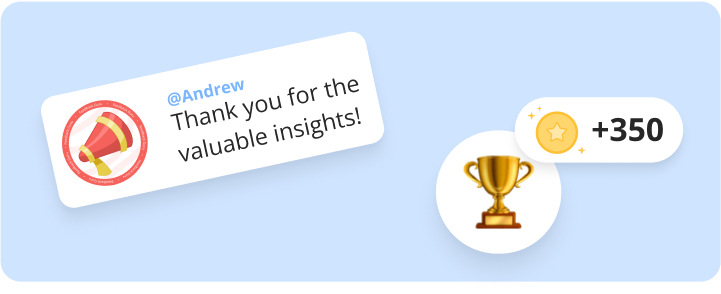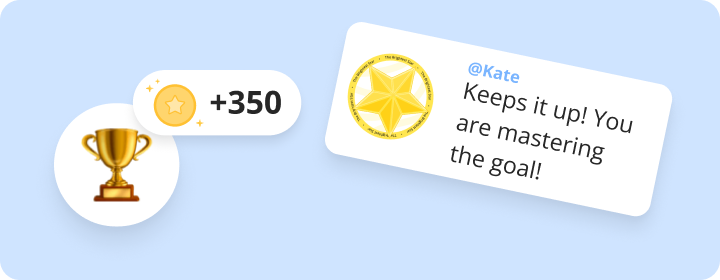All You Need To Know About Employee Recognition in 2025
Think back to the last time someone truly appreciated your work. Not just a passing “good job,” but a moment when you felt seen, valued, and proud of your contribution. That feeling — the emotional resonance of being recognized — is at the heart of employee recognition.
In today’s fast-moving, high-pressure work environments, it’s easy to get lost in deadlines and deliverables. But behind every project, sale, or innovation are people — and people thrive on acknowledgment. Recognition isn’t a nice-to-have. It’s a culture-defining force. It fosters purpose, boosts morale, and reinforces everything you want your organization to stand for.
This guide explores what employee recognition means in 2025, why it matters more than ever, how different types of recognition affect the employee experience, and what it takes to build a recognition strategy that works — no matter the size or structure of your company. Whether you're an HR leader, team manager, or simply someone who wants to help others feel appreciated, this is your go-to playbook.
Let’s start with the basics.
What Is Employee Recognition?
Employee recognition is the act of acknowledging and appreciating employees for their efforts, achievements, behaviors, and contributions in a meaningful and timely manner. Whether it’s a public "thank you," a shout-out in a meeting, a personalized note, or a structured award, recognition helps employees feel seen and valued.
It’s not about expensive rewards or grand gestures — it’s about consistency and authenticity. A good recognition program builds a bridge between company values, desired behaviors, and everyday actions. When you recognize employees effectively, you're reinforcing the habits and culture your organization wants to grow.
The goal is simple: to create a workplace where employees feel recognized, understood, and appreciated — not just for their results, but for how they show up every day.
Why You Need Employee Recognition
As the workplace evolves, recognition becomes a critical lever for success. It drives behavior, fosters belonging, and fuels a cycle of engagement that touches every corner of your organization.
Without recognition, even your best people can feel invisible. They may start questioning their purpose or feel like their efforts don’t matter. Over time, this erodes employee engagement and increases the risk of burnout and attrition.
On the other hand, when employees receive genuine appreciation in a timely manner, they gain clarity, confidence, and motivation. It turns routine into impact and effort into excellence. Tools like Esteeme help make these moments consistent, personalized, and scalable across teams.
Why Employee Recognition Is Important in 2025
The modern workplace is more diverse, distributed, and dynamic than ever before. Remote employees, hybrid schedules, and asynchronous communication mean leaders must work harder to maintain connection, clarity, and culture.
In this environment, recognition isn’t just about boosting morale — it’s how you build trust and alignment at scale. In 2025, recognition serves four key roles:
It connects people across distances, giving teams a way to feel united even when they’re spread across time zones.
It reinforces purpose, helping employees tie their work back to organizational culture and impact.
It supports mental health, offering emotional validation that enhances well being.
It creates culture clarity, signaling what behaviors and outcomes truly matter.
When recognition is regular, strategic, and sincere, it becomes a powerful tool for shaping an ideal company culture.
What Are the Benefits of Employee Recognition?
Let’s break down the true ROI of recognition. Here’s what you gain when you put a strong employee recognition program in place:

1. Increased Retention
Employees who feel appreciated are far more likely to stay. Studies show that companies with strong recognition programs see up to 63% lower voluntary turnover. That’s not just money saved — it’s institutional knowledge preserved, relationships retained, and disruption avoided. High retention leads to better team dynamics, consistent delivery, and a more stable culture. When employees feel they’re valued beyond their output, they invest emotionally in the organization's long-term success.
2. Higher Productivity
When employees are recognized, they’re 12% more productive on average. Why? Because they feel safe taking initiative, confident in their direction, and connected to a larger goal. Recognition serves as positive reinforcement — a psychological nudge that their efforts matter. It transforms tasks from to-dos into meaningful contributions, encouraging people to bring their best thinking and energy every day.
3. Improved Team Performance
Recognition isn’t just individual — it’s viral. Teams that reward employees for collaboration, innovation, and shared wins experience 21% higher profitability and stronger team morale. Recognition builds camaraderie, encourages knowledge sharing, and makes collaboration feel rewarding rather than competitive. Public praise of teamwork also helps model ideal behaviors for others across the organization.
4. Stronger Alignment with Values
Tying recognition to core values gives those values life. It helps employees understand what’s expected, celebrated, and rewarded — creating a culture where purpose drives performance. Whether it’s resilience, empathy, or innovation, every recognition moment becomes a signal to the wider team: "This is who we are." Platforms like Esteeme allow you to tag recognitions with company values so that those signals stay visible and intentional.
5. Boosted Morale and Well-Being
Recognition is one of the simplest ways to lift someone’s day. It fosters a sense of belonging, combats burnout, and brings a human touch to even the most task-driven roles. When leaders and peers offer positive feedback in a timely manner, it supports mental and emotional health across the board. Over time, this builds a more resilient team, lowers stress, and supports both individual and organizational well being. High morale also correlates with better customer experiences and stronger brand advocacy — making recognition a true business multiplier.
5 Common Challenges in Recognition
Even companies that value appreciation often struggle with execution. Let’s explore the most common roadblocks and how to overcome them.

1. Inconsistent Recognition
When recognition is random or reactive, it loses power. Employees wonder why some people are celebrated while others are overlooked. This inconsistency creates confusion and can lead to disengagement, especially if recognition is perceived as subjective or sporadic. By establishing clear rhythms and rituals — such as weekly shout-outs, monthly highlights, or real-time tools like Esteeme — organizations can ensure frequent recognition happens consistently, across departments and locations.
2. Bias and Favoritism
Without clear criteria, recognition can feel political or performative. This damages trust and undermines the credibility of any recognition program. If certain employees are always in the spotlight while others are ignored, the result is resentment rather than motivation. Building equity into your recognition strategy means using data to surface underrepresented contributors, encouraging peer recognition, and applying a fair, transparent framework that everyone understands.
3. Lack of Tools
Trying to manage recognition through sticky notes, emails, or memory alone leads to missed opportunities and lost momentum. Without a system, recognition becomes ad hoc, hard to track, and impossible to scale. A digital employee recognition platform like Esteeme centralizes praise, simplifies nominations, automates workflows, and gives managers and employees a clear space to celebrate wins — big or small. It also provides valuable analytics to improve and evolve your program.
4. Limited Participation
When only managers or leadership teams give recognition, it creates bottlenecks and missed moments. Employees often witness great work before managers do, which makes peer to peer recognition a vital component of any successful program. Encouraging all team members to participate — through tools, prompts, and cultural modeling — democratizes recognition and makes it part of the everyday rhythm of work.
5. One-Size-Fits-All Approach
Recognition should be meaningful — and that means it should be personalized. Some employees thrive on public recognition, while others prefer a private thank-you or the chance to take on a passion project. A one-size-fits-all approach ignores these nuances and can even make recognition feel insincere. Strong programs offer a variety of recognition types: verbal praise, digital shout-outs, gift cards, experiences, extra time off, or even charitable donations in someone’s name. The more tailored the recognition, the more powerful the impact.
How to Build an Effective Recognition Strategy
Now that we've explored the benefits and challenges of employee recognition, it’s time to turn intention into action. A strong recognition strategy isn’t just a set of good ideas — it’s a framework that builds culture, scales appreciation, and drives measurable impact. Here's how to design a program that truly makes every employee feel valued.

Step 1: Define Your Purpose and Goals
Start by getting crystal clear on the "why." Do you want to reduce turnover, improve morale, highlight company values, or boost cross-functional collaboration? The clearer your goals, the easier it is to align your program and measure its success. Recognition should be a lever — not just a feel-good initiative — so tie it to business outcomes like retention rates, engagement scores, or performance milestones.
Step 2: Design Your Recognition Framework
Build a holistic recognition experience that includes both structured and spontaneous appreciation. Mix in formal initiatives like quarterly awards, service anniversaries, and "Employee of the Month," with day-to-day moments like thank-you notes, team kudos, or instant shout-outs. The key is to balance ritual with authenticity. With platforms like Esteeme, you can create customized award tracks tied to your organizational culture and leadership principles.
Step 3: Choose the Right Tools
Recognition won’t scale without the right infrastructure. Choose a recognition platform that allows real-time feedback, cross-functional visibility, personalized rewards, and analytics. Look for features like badges, leaderboards, nominations, and points-based systems. Tools like Esteeme let you automate praise campaigns, integrate with Slack, and keep recognition flowing — even in distributed teams.
Step 4: Empower All Employees to Participate
Don’t gate recognition behind management. Create a culture where anyone — regardless of role or title — can celebrate great work. Use peer to peer recognition features, team recognition boards, or social walls to give everyone a voice. This makes recognition feel organic and helps highlight contributions that might otherwise go unnoticed.
Step 5: Communicate, Launch, and Train
A recognition program needs a strong launch plan. Create awareness with a kickoff campaign, including clear messaging on why it matters, how it works, and what to expect. Train managers on how to give authentic, specific recognition and encourage them to model the behavior. Reinforce the habit regularly through company-wide updates or recognition "spotlight" moments in all-hands meetings.
Step 6: Monitor, Analyze, Improve
Recognition isn’t a set-it-and-forget-it system. Use your platform's analytics and employee listening tools to see who is receiving recognition, what kinds of behaviors are being rewarded, and where gaps might exist. Ask employees how often they feel recognized, and whether the program is resonating. Then, iterate. Adjust the structure, messaging, or reward mix based on feedback and participation data to keep your program fresh and effective.
A well-designed recognition strategy is a flywheel. The more momentum it gains, the more it reinforces itself. And when powered by tools like Esteeme, it becomes easier than ever to scale recognition in meaningful, measurable ways — across every role, every team, and every work environment.
Elevate Employee Recognition with Esteeme
You’ve seen the why, the what, and the how — now let’s talk about the who that can help you bring it all to life. If you're looking to go beyond sticky notes and sporadic emails, and instead embed recognition into the very heartbeat of your organization, Esteeme is your partner.
Esteeme is designed for organizations that are serious about shaping positive company culture, improving employee engagement, and recognizing people in ways that resonate. Whether you’re a small team starting fresh or a global enterprise scaling your program, Esteeme adapts to meet your goals.
With features like:
Customizable badges tied to organizational culture
Point-based rewards, gift cards, and team challenges
Analytics to help you track how employees receive and give recognition
Special campaigns for business day milestones, five year increments, or end-of-year awards
... Esteeme helps create a recognition system that supports your ideal company culture — one where more employees feel appreciated, perform better, and stick around.
👉 Ready to build a recognition strategy that actually works? Book a demo with Esteeme today
FAQs
- Recognition should be consistent and integrated into the daily flow of work. While weekly recognition is a strong benchmark for maintaining morale and employee engagement, it’s equally important to provide real-time feedback tied to specific actions. The key to effective employee recognition is timely recognition — celebrating contributions when they happen to create a stronger emotional connection. Platforms like Esteeme make it easy to automate and track frequent recognition across teams.
- Employees value different types of recognition depending on their personalities, preferences, and job roles. Some thrive on public recognition in front of peers, while others feel most appreciated through a private message from their manager. Tangible rewards such as gift cards, career development opportunities, or time off are also popular. A strong recognition program offers choice and personalization to reflect the diversity of your workforce, leading to greater employee satisfaction.
- Absolutely. In fact, small teams often have a stronger opportunity to build a close-knit recognition culture early on. Even low cost or no-cost tools like verbal shout-outs, handwritten notes, or celebrating small wins can go a long way in helping employees feel valued. For growing organizations, using a digital employee recognition platform like Esteeme ensures that your recognition efforts scale with you as you grow.
- Start with the numbers. Show how an effective employee recognition program can improve employee retention, reduce hiring costs, increase team performance, and promote alignment with company values. Connect recognition to strategic goals like productivity, performance reviews, or culture transformation. Sharing success stories and benchmarking data from other companies in your partnership network can help build a compelling case for executive support.
- Yes — and often more so. Peer to peer recognition creates a culture of appreciation that goes beyond hierarchy. When team members take time to recognize colleagues for their effort and impact, it boosts team morale, inclusivity, and mutual respect. Peer recognition helps more employees feel connected to the work environment, builds stronger cross-functional relationships, and reinforces core values through real behavior. With a platform like Esteeme, employees can easily give and receive praise that strengthens the entire employee experience.







